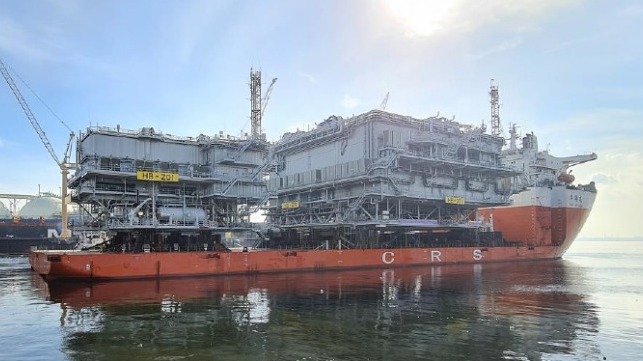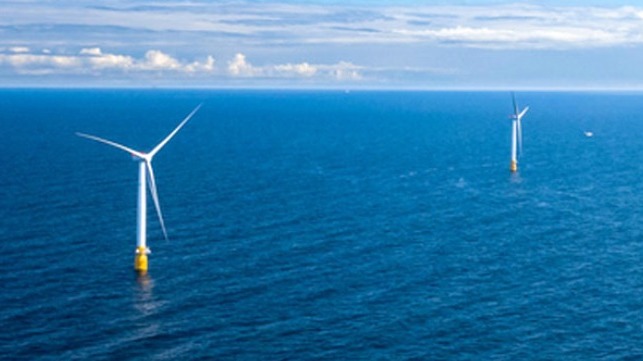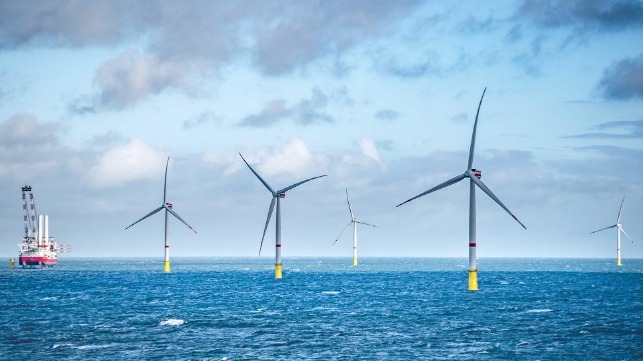Construction Proceeding on World’s Largest Offshore Wind Farm

Construction is proceeding with additional components completed for what is projected to become the world’s largest offshore wind farm. Located approximately 50 miles off England’s Yorkshire Coast in the North Sea, Orsted’s Hornsea Two Offshore Wind Farm will have a capacity of 1.4 GW when it goes into service in 2022.
Recently, Semborp Marine in Singapore completed the assembly of the topside units for the wind field consisting of the offshore substation and reactive compensation station. The construction is the largest AC offshore substation and combined with the other unit they together weigh over 10,200 tons. The two units were recently placed aboard a heavy lift vessel and departed Singapore on August 15. The substations are expected to reach the UK by late September. Once there they will be integrated with their jackets, which were installed in October 2020.
“With plans to have the wind farm operational in 2022, this is a very exciting milestone for Hornsea Two,” said Patrick Harnett, Senior Programme Director for Orsted. “Hornsea Two will be the world’s largest offshore wind farm and is already paving the way for future renewable energy projects which will have a significant impact on our mission to reach net-zero.”
The construction work at the installation site began in summer 2019 and continues to make strong progress. Recently, Rostock-based EEW Special Pipe Constructions announced that it had completed the last of the monopiles for the site. They were shipped to Eemshaven and from there are then being transported to the installation. A total of 165 monopiles were built in Rostock for the wind farm.
The site marked a key milestone at the end of May 2021, when the first turbine was raised into position. The first load out of turbines left the port of Hull in May on the installation vessel Sea Challenger, owned by DEME Offshore. The turbines include the new 265-foot-long blades which have been manufactured at Siemens Gamesa Renewable Energy’s blade factory in Hull.
In a recent update, they reported that as of mid-August 50 of the turbines were now in position. The completed array will have 165 8MW Siemens turbines installed, each standing 656 feet above sea level, with a rotor diameter of 578 feet.
South Korea Awards First Offshore Wind Farm License

South Korea awarded the first license for a floating offshore wind farm to be developed in a partnership between Macquarie’s Green Investment Group (GIG) and TotalEnergies. With a maximum installed capacity of 1.5 GW developed across three phases, the project is projected to be one of the largest floating offshore wind developments in the world.
The Ministry of Trade, Industry and Energy’s Electricity Regulatory Commission granted the partners an Electricity Business License (EBL) for their offshore wind project to be located near Ulsan, Korea. The EBL grants the partners exclusive development rights to progress the project’s first phase, which will consist of 504 MW. Detailed environmental impact assessments will now commence on phase one, and construction is expected to start in 2024.
“The award of an EBL is a significant milestone in the development of GIG and TotalEnergies’ Ulsan floating offshore wind farm,” said Shin Jungwon. TotalEnergies’ Country Chair for Korea. “We recently completed our wind resource measurement campaign, and having now been awarded exclusive development rights, we’re looking forward to starting detailed environmental impact and engineering assessments.”
The wind farm is part of South Korea’s Green New Deal that calls for the construction of 8 GW of wind-generated power as part of its plan to achieve carbon neutrality by 2050. Through the project, GIG and TotalEnergies said they aim to help deliver the Korean government’s Green New Deal, revitalize local economies, and support high-skilled employment opportunities. The partners are committed to utilizing the local supply chain whenever possible and are actively collaborating with shipbuilders and heavy industry companies in Ulsan to help revive Korea’s offshore industries.
“With its fantastic infrastructure and offshore experience, Ulsan is the perfect location for floating offshore wind development. That’s why GIG and TotalEnergies are joining hands with Korea’s world-class shipbuilding and offshore industries to deliver this market-leading project. By bringing together specialist local know-how with GIG and TotalEnergie’s global expertise, the Ulsan project will place Korea at the forefront of the global floating offshore wind market,” said Woojin Choi, Managing Director, GIG Korea.
Once operational, the full 1.5 GW project is expected to produce enough electricity to power the equivalent of over 1.5 million households and reduce emissions by approximately 2.3 million tCO2e per annum.
It is also the first of several projects the partnership is seeking to develop. GIG and TotalEnergies also recently submitted a bid into Scotland’s latest offshore wind leasing round, ScotWind, and secured rights to develop the 1.5 GW Outer Dowsing Offshore Wind project off the east coast of England.
Senators Propose Bill to Spur Offshore Wind Manufacturing and Vessels

U.S. Senators representing Massachusetts and New Jersey are proposing legislation that they say will help to spur the domestic manufacturing and deployment of offshore wind projects. Saying that to date the offshore wind supply chain is concentrated in Europe, China, and South Korea, the senators from two of the states expected to be the first to launch large scale offshore wind farms are calling for investment tax credits and a production tax credit for qualified offshore wind components and dedicated offshore wind vessels.
Calling their proposed legislation the Offshore Wind American Manufacturing Act, they said it would prioritize American workers and require prevailing wages for laborers involved in the construction and expansion of qualified manufacturing facilities or the manufacture of qualified offshore wind products. Many states have already proposed massive programs to create wind ports and manufacturing sites as part of a means of rehabilitating ports and supporting the birth of the offshore wind industry. In addition, the U.S. has already said that vessels involved in the wind sector would be subject to the Jones Act in a similar fashion to how the cabotage laws were applied to the offshore oil and gas industry.
“Offshore wind is a booming market, but without effective manufacturing policy, American workers will be left behind,” said Senator Edward Markey of Massachusetts. “The Offshore Wind American Manufacturing Act helps ensure that each offshore wind turbine deployed in the United States over the next 10 years is made in America.”
The proposal calls for the creation of a 30 percent investment tax credit for qualified facilities that manufacture offshore wind components and subcomponents that would reduce the high capital costs required to build, upgrade, or retool a facility. The investment tax credit would be complemented by a new production tax credit that ranges from two to five cents per watt multiplied by the total rated capacity of the turbine. The production tax credit varies by components including blades, towers, nacelles, generators, gearboxes, foundations, and related vessels.
“Federal investment in offshore wind manufacturing is good for the environment, good for the economy, and good for the American people,” said co-sponsor of the proposal Senator Robert Menendez of New Jersey. “It will create good-paying jobs, expand the nation’s manufacturing base, and keep the U.S. on the cutting edge of new, green technologies, ensuring our nation’s economic competitiveness in the face of emerging environmental challenges.”
The full investment tax credit would be available until December 31, 2028, and phase out annually afterward. The production tax credit would be available until December 31, 2030.
In introducing the proposal, the senators said that the offshore wind industry is a critical part of the U.S. efforts to combat climate change and create energy independence. They are confident that their proposal would help create thousands of manufacturing jobs and ensure that the United States meets President Joe Biden’s offshore wind goal of 30 GW by 2030.
No comments:
Post a Comment